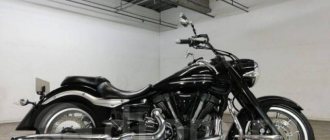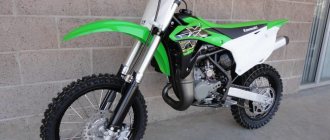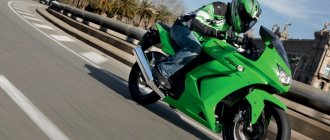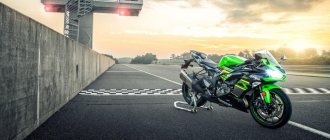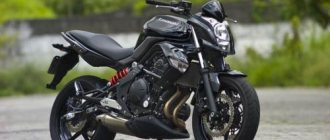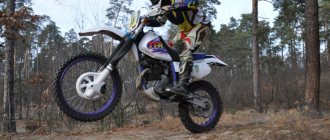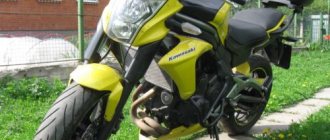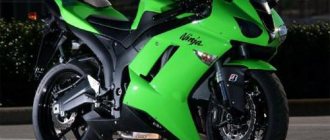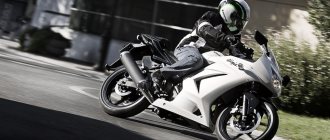2014 onwards, 903 cm3, 48 l. pp., 282 kg, 170 km/h, 460,400 rub. (price in 2021 - from 647,000 rubles)
text: Anton Vlasov photo: Nikita Kolobanov
In the photo: Anton Vlasov
»The Vulcan series cruisers are one of the oldest families of Kawasaki road motorcycles: this year the VN line turns... 30 years old! All this time, the Japanese manufacturer worked on mistakes and improved the Vulcans, which, having survived to this day, have become modern and high-tech motorcycles that have not lost the charm and allure of classic cruisers. The medium-sized model Kawasaki VN900 is the “junior” device of the legendary series, available on the Russian market.
The history of the Kawasaki Vulcan family began with the VN750 model, which debuted in the mid-80s of the 20th century. It was one of the first cruisers of the Japanese concern, equipped with a V-shaped 2-cylinder engine, and it was the “entrance ticket” to the capacious North American market. The device turned out to be so successful that it existed without major changes until 2006!
For a long time, in parallel with the VN750, the VN800 was produced, which, despite the close relationship and a slight difference in engine displacement, was a fundamentally different motorcycle, a modern cruiser, with a different engine and a pendulum rear suspension with an “invisible” Softail-style monoshock absorber.
Like the VN750, the 800 cc version was produced until 2006, when, by a strong-willed decision of the management of the Kawasaki concern, the two models were replaced by one - the VN900. As before, the motorcycle is produced in several versions: Classic, Classic Special Edition, Classic LT and Custom.
Technically, stylistically and conceptually, the basic VN900 Vulcan Classic, to which this material is dedicated, is a typical and, dare I say it, classic cruiser, the likes of which are in the model lines of all four Japanese motorcycle concerns. Steel frame, V-shaped 2-cylinder engine, large streamlined gas tank with a dashboard in the center, wide steering wheel, “thick” spoked wheels, deep fenders, round headlight and other standard features.
Although in the world of uncompromising lovers of chromed iron, the engine cylinder displacement of 903 cm3 is a rather modest value, with which, in fact, “adult” motorcycles just begin, the VN900 Classic has the most universal ergonomics: both fat and thin people can comfortably sit behind the wide handlebar of a cruiser , and tall, and “short”, and, in general, perhaps, any riders.
The only criticism I have about the Vulcan is that, in my opinion, the steering wheel is not the most comfortable, or rather the throttle handle. Due to the smooth curve of the “crossbar”, like the line of a sika deer’s antlers, and the thick accelerator handle, which form a specific grip, in my case, by the end of the day, my right hand began to ache. However, individuals with larger limbs most likely will not have problems.
The test bike was equipped with numerous branded accessories from the official Kawasaki catalogue. I don’t know whether it was intentional or not, but the set of parts was selected in such a way that the VN900 Classic “grew up” and even “outgrew” the Classic LT modification, which differs from the basic version in a high windshield, side leather trunks, a backrest for the passenger and additional headlights.
In addition to this, the test vehicle was “screwed on” with other steering wheel grips, a leather gas tank cover with a small pocket, roll bars, a large Vulcan emblem on the windshield, a luggage area and a headlight visor. I can't say that I'm a big fan of this style, but fans of such cars should appreciate it.
Sleeping volcano
There are not many requirements for the engine of a mid-sized cruiser, and the Kawasaki 903 cc V-twin easily “covers” them all: there is “even” power and torque delivery, and a nice design of the power plant itself, and a moderate level of vibrations, and even some high technologies that you rarely see on a V-shaped “two” device of this class.
For example, like the engines of road sports models, the VN900 Classic engine is equipped with the proprietary Kawasaki Dual Throttle Valves system, the essence of which is the use of two throttle valves in the intake channels: the first is connected by a regular cable to the throttle handle, the second, with a smaller diameter, is controlled servo drive. Due to the Dual Throttle Valves technology, the most accurate dosing of the fuel-air mixture occurs and, as a result, smoother engine reactions to the opening of the gas, as well as reduced fuel consumption.
In addition, closer to the cylinders, the intake ports become narrower, which increases the flow rate of the mixture and improves engine efficiency. Like most V-twin Japanese cruisers in the “up to 1000 cm3” category, the Kawasaki VN900 Classic engine is equipped with a liquid cooling system, although outwardly it carefully disguises itself as an honest “air blower”.
If you ignore the age-old debate about what is better for a cruiser - air or liquid cooling, which has long passed into the irrational sphere of “holy war”, then for urban use the VN900 Classic engine is a little more convenient than orthodox American power plants. Or rather, not “more convenient”, but more comfortable - and even in the abnormal heat for Moscow of 30 ° C, in which I was lucky enough to test the Kawasaki cruiser in all the capital’s traffic jams, I did not experience much discomfort due to the hot V-twin.
However, you should not be under any illusions: you won’t get much coolness from the VN900 Classic engine either, and when the cooling system fan turns on (and when driving slowly it doesn’t stop at all...), it’s not cool air from the mountain peaks that blows into your feet...
From this position, I was once again convinced: a large V-twin engine is not the best power plant option for a city motorcycle. The Kawasaki VN900 Classic engine lacks character, which is typical for mid-level cruiser powerplants. Good torque at low and mid-range speeds, sluggish performance at high speeds and modest fuel consumption of 6.5 liters per 100 km - the 903 cc V-twin is quite enough for sedate driving.
But at a slightly more “agile” pace, of course, situations arise when you regret not driving the VN1700 - for example, if you need to quickly accelerate to change lanes in traffic, and the 48-horsepower engine of the VN900 Classic reacts rather sluggishly to the movement of the handle “ gas."
But this is by no means a drawback of the motorcycle, but a typical feature of all cruisers with a similar engine size - as is the absence of a sixth gearbox! I don’t know what motivated the Japanese engineers, but even at 120 km/h I really want to switch to a higher gear, which for some reason is not in the transmission. The gearbox itself works great: the shifts are clear, the shift of the gearbox foot is moderate, and the gear lever, traditionally for cruisers, is double-shouldered, which makes it possible to press it with your heel - this is important if you are a fan of a brutal style and drive in large shoes.
I liked the proprietary “neutral” search system: when the motorcycle is in first gear, you just need to pull the gearshift lever up, and instead of switching to the second stage of the transmission, neutral will be activated. The VN900 Classic has a class-record wide rear wheel measuring 180/70–15, while competitive models from other Japanese manufacturers have a more modest 170 mm wide rear tire.
To maintain good maneuverability of the motorcycle, Kawasaki engineers made a number of tricks: for example, the angle of the VN900 Classic fork is a relatively modest 32° by cruiser standards, plus the center of gravity was as low as possible and the most “urban” weight distribution along the axles was selected, due to which The device really “steers” perfectly at any speed!
This is especially felt in tight corridors formed by cars stuck in traffic jams, where the massive and wide Kawasaki cruiser, although it does not flutter like a mini-moto, behaves very obediently and does not strive to fall into another Lamborghini or Porsche frozen in traffic...
The motorcycle suspension did not leave any vivid memories in my memory. Which, however, is also not bad: even when the VN900 Classic was loaded with a passenger, the device did not turn into a popsicle “floating” in the sun, although the swing of the chassis became much more noticeable. To perform the tasks that cruisers of this class regularly face, the potential of the fork and monoshock of the 900 Vulcan is quite sufficient. Overall, the Kawasaki VN900 Classic is a fairly smooth model, well balanced and self-sufficient.
The only thing that slightly spoils the impression of the device are the very sluggish brakes: two 2-piston calipers are called upon to stop the 282-kilogram car - one at the front and one at the rear, respectively. I understand that discussing the effectiveness of a cruiser's braking system is something of a taboo, but in the case of the VN900 Classic, the situation is really bad.
Of course, I succeeded in making the difficult vehicle quickly slow down, but it required titanic efforts applied to the front and rear brake levers! And considering that there is no feedback in principle (like ABS too...), blocking the wheel is a very real prospect. Especially if a newbie gets behind the wheel of the VN900 Classic.
Test drive KawasakiVulcan 900 Custom, SuzukiBoulevard M50
Why do they love choppers? For external beauty, a certain charisma of style, pathos... Everyone finds something of their own in them. The buyer of such motorcycles is of little interest in their technical characteristics. Well, perhaps the displacement of the engine. And, although the main attention is often paid to appearance, there is a certain level (and it is both moral and technical) for the “sufficiency” of engine volume. And in our case, both test participants correspond to it. At the same time, they are both technically close and, at the same time, quite different from each other, and, as it turned out, not only externally. Their “intra-class” differences clearly place them in opposite corners of the ring. Oh, I'm sorry – I meant to say “market”!
On American versions of motorcycles, the first thing that irritates us is the speedometer marking in miles per hour. Of course, there are markings in kilometers per hour, but they are very difficult to discern.
One of the positive features of the Suzuki is rear wheel drive via a cardan shaft. For our conditions, this is still better and more reliable than a belt.
Boulevard M50 (European name - Intruder M800) is a representative of the Suzuki family of power cruisers. Of course, compared to the flagship of the line, the Boulevard M109R (Intruder M1800R), its engine capacity is not at all impressive, and its design is more similar to classic cruisers. But pay attention to the details: an inverted telescopic fork, a liquid cooling radiator hidden between the front frame pipes, a miniature front and wide rear fenders - very radical solutions for pure “classics”. And only one detail allows us to doubt its complete professional suitability for the subclass of power cruisers - the absence of a second brake disc at the front. If we are to position the motorcycle as a power cruiser, then be so kind as to take care not only of the appearance and engine, but also of proper brakes. After all, as practice shows, he really doesn’t have enough of them. However, the engineers did not bother to eliminate this drawback even in the new 2010 model, whose design is already more reminiscent of the “sports” Boulevard M109R and Boulevard M90.
Kawasaki Vulcan VN900 Custom is a representative of a different trend of custom bikes that is popular nowadays. The main thing in it is not functionality, but His Majesty style! Perhaps that is why the designers of the model limited themselves to a “one and a half” seat, on which the passenger will be uncomfortable (although if she is a petite girl, then she will get from the cafe to the beach quite comfortably on it). But visually it unloads the rear of the motorcycle. The front part of the bike is decorated with a 21-inch cast light alloy wheel with a sophisticated spoke pattern and a typical narrow tire. In the 2009 Ebony Special Edition that we tested, the designers also focused on the engine. Its cylinder covers are painted matte orange. The presence of chrome is kept to a minimum - instead, black and muted bronze colors rule the roost. Even the muffler pipes are painted matte black.
I've previously ridden Vulcans with pseudo-hardtail rear suspension similar to the one on the test bike. And, I remember, the sensations were the most “hard” ever. That is, if the presence of the rear suspension was felt, it was only slightly. That's why, while looking at the VN900 Custom before the test, I was mentally prepared for the fact that my butt would have a hard time. I wanted to loosen the rear monoshock as much as possible, but it turned out to be not located very well, and it would have taken a lot of time to get to the adjusting ring. So I decided not to bother and left the spring preload adjustment in the middle position, limiting myself to only adjusting the pressure in the rear cylinder, lowering it to 2.2 atmospheres. As it turned out, this was enough to feel comfortable in the Vulcan seat when driving alone. Due to the lack of a full-fledged passenger seat, I did not risk the photographer with his expensive equipment and use him as a passenger.
But this is even for the better; at that moment I didn’t want to share the pleasure of riding the Vulcan VN900 Custom with anyone. Situated behind the Boulevard M50, I slowly crossed the urban jungle, and had to admit that the motorcycle felt quite comfortable in it. The small width of the steering wheel and low center of gravity make it easy to squeeze between the rows of cars piled up at a traffic light, and decent acceleration dynamics allow you to be the first to go green from the start.
Thoughts about the rigidity of the rear suspension disappeared after a couple of kilometers. On this motorcycle, the “pseudo-hardtail” only looks intimidating, but in fact it copes with its direct responsibilities very well. In addition, unlike the passenger seat, the driver’s seat turned out to be quite soft and comfortable, and most importantly, well profiled. Therefore, if the suspension did not have time to handle any irregularities, after it there was another “filter” that softened the blows.
Before the test, I had another concern. Looking at the large but narrow front wheel and wide rear wheel, it looked like the bike would handle like your average chopper. That is, in order to enter a turn, you will have to “ask” it well... But here, too, a miracle happened - this “900” turned out to be surprisingly maneuverable at almost any speed. Apparently, the correct calculation of the angle of inclination and the amount of fork offset played a role. Even when driving at walking speeds, this heavy chopper showed no desire to fall on its side. But in the Suzuki Boulevard M50 this effect was present and was especially noticeable when driving with a passenger.
Compared to the large 21-inch front wheel, even a three-hundred-millimeter brake disc looks small and does not inspire confidence. Considering that it works in tandem with a budget two-piston caliper, you can’t expect high power from it. In practice, everything turns out to be the same as in theory. For effective braking, using one front brake is clearly not enough. Additional assistance is required in the form of a rear disc brake. And it’s nice that this help radically changes the situation, completely satisfying the pilot’s requests regarding the deceleration rate. In the case of the Kawasaki Vulcan, the rear brake is a full-fledged functional part of the motorcycle, which is simply necessary to use. And, as it seemed to me, despite the fact that in most motorcycles the main brake is considered to be the front one, in this bike the main one is still the rear one.
If you change from a Kawasaki Vulcan to a Suzuki Boulevard, the first thing you lose is the feeling of riding a luxury motorcycle that literally attracts the attention of passers-by. Boulevard M50 looks very simple compared to its competitor. Although, if we were comparing the M50 with the regular version of the Vulcan VN900, and not the limited Custom, the difference in the perception of the external appearance of the motorcycles would not be so great.
The second point is sound. Whatever you say, Kawasaki's is richer and bassier, and therefore evokes more emotions than the ordinary muttering of Boulevard's chrome-plated pipes.
Another thing is the character of its engine! Almost 100 cubic meters of minus difference does not allow it to beat its competitor from Kawasaki, but it is able to take away from it that part of buyers who prefer the groovy nature of the motorcycle to style and riding it with a decently open throttle. Unlike the Kawasaki Vulcan's powerplant, Suzuki's V-twin is more responsive at mid- and high-end revs. But he doesn’t like driving “tight” at idle. At the same time, Kawasaki “loves” low revs and allows you to accelerate without jerking in any gear from 1500-2000 rpm. Perhaps the reason for such flexibility lies not only in the engine settings, but also in the type of rear wheel drive. For the Kava, this is a toothed belt that can better smooth out the pulsations of the twin than the cardan installed on the Suzuki Boulevard. This is why the Boulevard M50 is not so comfortable to drive and accelerate at low speeds. As for vibrations, the engines of both motorcycles are so well balanced that they are practically unnoticeable.
The Boulevard M50 steers as befits a “sporty” cruiser. But, what is very strange, I always had a feeling of heaviness in the steering wheel, which I did not notice on the Kawasaki Vulcan. Perhaps it’s due to different weight distribution and steering column geometry, because in terms of dry weight, both bikes are almost identical.
But I didn’t feel much difference in the performance of motorcycle suspensions. In my opinion, the Boulevard M50, like its rival, is capable of digesting our broken asphalt to some extent, but it’s better not to provoke it again - otherwise you’ll get a “kick in the ass.” The front fork provides the rider with good road feel, making it easy to control the bike even in tight corners. Whatever you say, the Boulevard is more inclined to an aggressive driving style; its opponent has a front wheel that is too narrow for this, which does not provide the same reliable grip on the road surface. Because of this, the Kawasaki Vulcan 900 Custom is unlikely to keep up with the Boulevard M50 on winding roads.
The driver who brought the Boulevard M50 to us for testing immediately noticed that the brakes on this example of a motorcycle were terrible (though before that he had driven a sportbike). The check showed that this is so. The front brake is very weak in grip, and you have to apply significant force to the handle to slow down quickly. The rear brake, which on choppers and cruisers should work like a clock, also “grazes the rear ones.” Predicting the behavior of the rear wheel when pressing the pedal was very problematic. Imagine my surprise when I discovered that the rear brake on this motorcycle is a drum brake! I understand that there is such a thing as “tribute to style,” but this is on an expensive “sport cruiser”! No, with such an attitude towards potential buyers, I would not hope for the success of the model. Buying candy just for the sake of a beautiful wrapper is not for us. At a minimum, it should also be tasty.
Middle class
Opinion: Valery Chuikov
When someone comes to the conclusion that he has no desire for anything else but a chopper, as they say, “he has no soul,” he just has to decide on the engine capacity, make and model. Some pay attention to the leisurely and cheap Japanese four hundred, and those who can afford not to be modest try on “much more than a liter.” But it’s not for nothing that the expression “golden mean” exists! It also exists in this class - these are motorcycles with engines from 800 to 1100 cm3. They have quite fast engines and at the same time not exorbitant prices. We tested two of the brightest representatives of the mid-sized chopper class - the Suzuki Boulevard M50 and the Kawasaki VN900 Custom (in the Special Edition version).
The first one I got was a Suzuki. Once upon a time, back in 2007, I took part in a test of the “American” Suzuki Marauder (with a chain drive) and for some reason, after starting on the M50, I immediately remembered it. The reason for this was the eight hundred cc V-twin, with a character that has not changed much since then. Yes, it has changed somewhat from the inside, received an injection system, but at the same time retained its perky, I would even say mischievous character with a juicy “middle” and pick-up at the “tops”, but, unfortunately, sluggish bottoms. It provokes active driving, and driving it “retirement style” slowly and sadly is unnatural for it. At the same time, it steers quite adequately (within the class, of course), although with a passenger at low, so to speak, “traffic” speeds, it is prone to stalling. But the brakes clearly do not correspond to the character of the engine - the front one still works tolerably in the city, but is not very informative in emergency situations, and the rear one is generally inadequate - when pressed carefully, it brakes weakly, and when “using brute force” it blocks the wheel. The suspensions, in principle, cope well with uneven surfaces, but when driving with a passenger (and our photographer was sitting behind me), the rear one gives in to speed bumps and other serious irregularities. For the sake of the purity of the experiment, it would be necessary to pre-press the spring, but getting close to adjusting it turned out to be a difficult task and we abandoned this idea. But the passage of the usual unevenness of the city asphalt of Odessa was quite comfortable. What I can say for sure is that when driving “fully loaded” (passenger and luggage), you should be careful during intense acceleration - the weight distribution changes, causing the front wheel to be noticeably unloaded and the Boulevard’s handling deteriorates sharply.
I switched to the VN900 Custom and, despite my dislike for choppers, I understood why this model was recognized by buyers! If the M50 takes a lot of time to get used to it in all aspects - from the throttle to the brakes, then in the saddle of this “Vulcan” you immediately feel comfortable, and the expression “at ease” is very appropriate here. Yes, it is clearly a “solo sailing” motorcycle, although it is quite possible to give a girl a ride from her house to a cafe. And although the passenger here will definitely feel like “number two,” the ergonomics of the driver’s seat deserves the highest rating! Everything is convenient on it: driving straight, turning, braking. Gear shifts are quieter and clearer than on the Suzuki, and at ultra-low speeds it is more stable, which means it is more convenient to drive around the city in heavy traffic; in many ways, the process is facilitated by a narrower steering wheel. The suspension simply amazed me with its comfort. Compared to the second participant in the test, it definitely copes better with various irregularities; we can say that it is almost at the level of a good road worker, although, of course, you should not abuse these qualities. And the engine does not exhibit aggressive traits. But at the same time, it has excellent traction at idle and very decent acceleration dynamics, so you can always count on good acceleration at the right time.
Based on the results of this test, I can assume that the VN900 Custom should appeal to those who do not intend to travel far with a passenger, but expect to make frequent trips around the city. It is bright, stylish and comfortable. The M50 will most likely be chosen by those who want to not only parade from the cafe to the embankment, but also intend to make “forced marches” with their companion to other cities for rallies or simply to the sea.
Text: Vladislav Sofonov
Photo: Andrey Shlenchak
Eyjafjallajökull
Some volcanoes are eternally sleeping mountains, more like ordinary hills, others, on the contrary, are frightening giants, in the event of a real eruption, threatening entire cities and even regions with terrible disasters... Kawasaki VN900 Classic is a volcano of a different kind, a kind of, pardon the expression, Eyjafjallajökull, which nothing special - but only until it is activated.
This motorcycle hardly stands out from the crowd of similar machines, but once you get to know it better, you won’t want to part with the VN900. The device impresses with its simplicity and predictability: despite its impressive weight and not the most modest dimensions, the Kawasaki cruiser is comfortable and completely under control even at low speeds.
Yes, the VN900 doesn’t have even a tenth of the status of American devices... which, in my opinion, makes choosing the Vulcan an even more reasonable purchase, since for significantly less money the Kawasaki motorcycle offers a high level of comfort, decent ride quality, classic design and traditional Japanese reliability with the eternal and unchanging values of equipment of this class. /
Tags
Kawasaki Cruiser Tests and Reviews Chopper
Video
Kawasaki VN 1500 Vulcan
- a heavy cruiser made in a classic style, extremely popular all over the world. The model goes back to the 80s, being a descendant of the VN-15 modification, which featured an engine and a 4-speed transmission. In 1996, the outdated predecessor was replaced by the new Vulcan, which was noticeably different from the previous model and was produced in four different versions. Strictly speaking, there were five versions - there was also a Kawasaki Mean Streak, but it has little in common with the classic Vulcan, and a separate article is devoted to it. And so on the market you can see four different Vulcans that rolled off assembly lines from 1996 to 2004. The most common Kawasaki Vulcan 1500 Classic, the standard version with spoked wheels and one brake disc on the front wheel. Following it was the Classic Tourer version, which featured alloy wheels, a different size front wheel, a different exhaust, plenty of chrome, as well as pre-installed panniers and a windshield. The Kawasaki Vulcan 1500 Nomad version is similar to the Classic Tourer, but has a larger fuel tank to 19 liters, hard plastic panniers painted in the color of the motorcycle, and two brake discs on the front wheel. The fourth version of the Vulcan, the Kawasaki Vulcan 1500 Drifter, stands completely apart - it is a motorcycle stylized as the legendary Indian with deep wings, a unique saddle and an injector. The Kawasaki Vulcan 1500 engine has excellent performance at low speeds (peak torque occurs at 2800 rpm) and produces 54 hp and 112 nm of torque. All motorcycles were equipped with a liquid-cooled V-twin, a cardan drive and a 5-speed transmission. Since 2002, motorcycles equipped with injectors have gone into production. The maximum speed of the VN 1500 is about 180 kilometers per hour, but a comfortable cruiser without vibrations and increased gas consumption is no more than 140 kilometers per hour.
Massive and heavy, this cruiser handles surprisingly well. Of course, its large mass (from 290 to 335 kg depending on the version) requires certain physical characteristics from its rider, but, nevertheless, the Kawasaki Vulcan 1500, by the standards of the class, handles really well, calmly turning up to the footrests in steep turns. The low-revving engine allows you to start sharply, although it runs out of steam once you reach the upper third of the rev range. The brakes, of course, could be better - they are clearly not enough for such a heavy motorcycle. The situation is somewhat better only with the Kawasaki Vulcan 1500 Nomad modification due to two brake discs at the front, while the rest of the brakes are somewhat lacking. However, the shiny chrome and growling exhaust cruiser is more conducive to a non-aggressive and relaxed ride than to racing on city streets. The suspension of all modifications of the Kawasaki Vulcan 1500 is classic - a telescopic fork at the front and two shock absorbers at the rear. However, according to reviews from some owners, it is characterized by excessive softness, which may not always be appropriate on Russian roads, since it sometimes “breaks through” in potholes, especially if the motorcycle is loaded with a couple of people and luggage. But what the VN 1500 cannot be denied is comfort. Of the four, the Kawasaki Vulcan 1500 Nomad is best suited for the role of a touring motorcycle - a larger gas tank (19 liters versus 16) and excellent standard panniers are a great help on long trips. When driving slowly at a cruising speed of 120 km/h, fuel consumption does not exceed 6.5 liters per hundred kilometers, and the engine readily digests AI-92, although it is very picky about the purity of gasoline.
We can say that the Kawasaki Vulcan 1500 is a typical cruiser in the good sense of the word. Big, beautiful, with a typical chopper engine, it will certainly appeal to fans of this style. Of course, its size, weight and power require that the rider has a good amount of experience before riding the VN 1500, but it’s not for nothing that this bike has such a huge following. It has much more advantages than disadvantages.
Specifications
The generally balanced technical characteristics became especially good a few years after the start of production of the Kawasaki Vulcan 1500. The first few years the bike had too much in common with the outdated and overly archaic VN-15, but later it was refined and became noticeably different from its “ancestor” . We can’t say that the bike stands out in any way from its competitors, but it can be safely called a strong mid-ranger. A solid cruiser with an engine capacity comparable to that of a car – isn’t that enough to love it?
Engine
The 1470 cc 4-valve V-Twin liquid-cooled engine migrated to the Vulcan 1500 Classic from the VN-15 virtually unchanged. The impressive power unit produces 65 hp. at 4700 rpm, and the maximum torque of 112 Nm (114 for injection modifications) is available already at 3000 rpm. “Tractor” traction is one of the reasons for the popularity of the Kawasaki VN 1500. The top gear can be engaged already at 60-70 km/h, and you can be sure that the bike will take this calmly. It is worth keeping in mind that until 1999 these motorcycles were equipped with a carburetor, and since 2000 - with an injector. Instances with a fuel injection system received the prefix Fi (Fuel injection) in the name. As for acceleration from 0 to 100 km/h, it varies from 5 seconds for the Mean Streak to almost 7 seconds for the Nomad.
Transmission
For the first two years, the Kawasaki VN 1500 was equipped with a 4-speed transmission, reliable, but very ancient - it was inherited from the VN-15. All newer copies were equipped with gearbox-5, and this modification had almost no effect on the dynamics. The gearbox does not seem to operate very smoothly, but it is distinguished by excellent reliability, and owners rarely complain about problems with it.
Chassis and brakes
Here the archaic nature of the Vulcan Classic manifested itself in all its glory. Steel frame, massive engine - hello, three hundred kilograms of weight! However, the bike’s suspension is not bad, despite the significant unsprung weight due to the cardan drive. But the brakes are weak on all versions except the Mean Streak, and they are objectively not enough to effectively stop a heavy motorcycle capable of accelerating to 180 km/h. But, although the Kawasaki VN1500 Vulcan is capable of such speeds, it is better not to risk it - already at 140-150 km/h the bike turns into a cast-iron anvil, flying along the road strictly in a straight path.
Electronics
All the electronic stuff comes together in a compartment located in the bowels of the bike, under the saddle, where it is reliably protected from the weather. There is nothing extraordinary about it - a standard wiring between optics, ignition, generator and battery, assembled together in a switch, which bikers usually call simply “brains”.
Weight and dimensions
Despite the attempts of Japanese engineers to lighten the design, the motorcycle still turned out to be large and heavy. The Vulcan Classic weighs from 292 kg, and this is a dry weight without fuel, oil and other liquids, while for the Nomad this parameter reaches 337 kg. But we must give it its due - thanks to the center of gravity shifted downwards, this weight is not felt at all, and even a puny motorcyclist will not have problems parking when the bike has to be rolled back and forth with its legs a little. But the wide steering wheel creates certain inconveniences when driving around the city.
Controllability
At low speeds the bike is difficult to control due to its size, weight and tendency to tip over. At its maximum speeds, the picture is also sad, and making the Kawasaki VN 1500 change direction at 150 km/h is not so easy. But let's be fair - otherwise it handles well, and in the range from 20 to 120 km/h there are no problems with taxiing.
